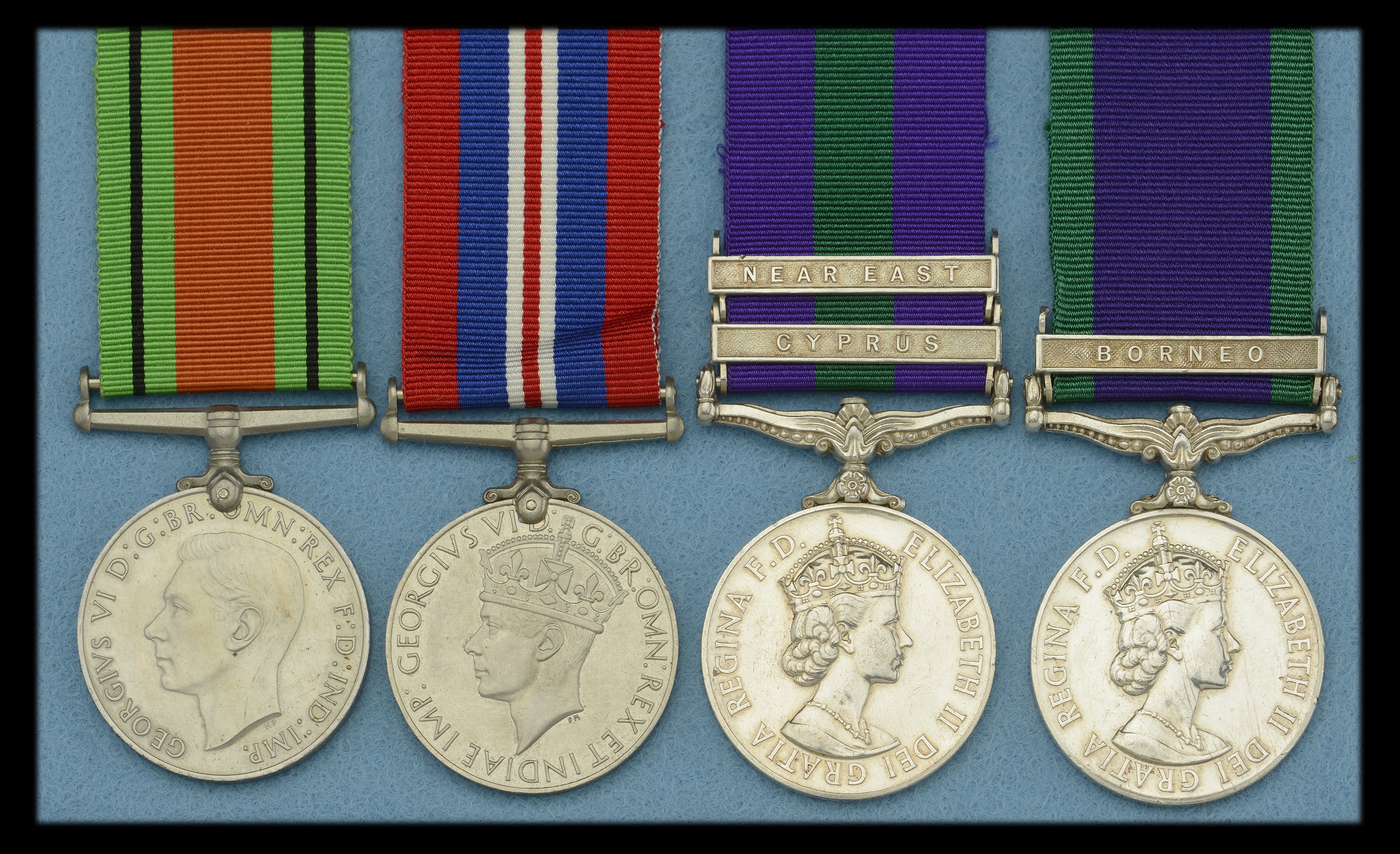338
Four: Squadron Leader J. A. Judd, 114 Squadron, Royal Air Force, who flew as navigator in...
Bids do not include VAT, buyer’s premium or delivery.
By confirming your bid, you agree that you have read and accepted the-saleroom.com and the auctioneer's terms and conditions. Confirming your bid is a legally binding obligation to purchase and pay for the lot should your bid be successful.
Choose one of the quick bid options below:
Bids do not include VAT, buyer’s premium or delivery.
By confirming your bid, you agree that you have read and accepted the-saleroom.com and the auctioneer's terms and conditions. Confirming your bid is a legally binding obligation to purchase and pay for the lot should your bid be successful.
Defence and War Medals 1939-45; General Service 1918-62, 2 clasps, Cyprus, Near East (Flt. Lt. J. A. Judd. R.A.F.); General Service 1962-2007, 1 clasp, Borneo (Sqn. Ldr. J. A. Judd. R.A.F.) mounted on card for display, minor edge bruising, very fine (4) £500-£700
---
James Alexander Judd was born in January 1923. He enlisted in the ranks of the Royal Air Force in June 1942, and advanced to Navigator II (equivalent to Sergeant) before being commissioned Pilot Officer on a Short Service Commission in April 1949. Judd advanced to Flight Lieutenant in December 1952, and served as A.D.C. to the the A.O.C. and Commandant of R.A.F. Technical College, Henlow from April 1954.
Judd subsequently served with 114 Squadron during the Suez campaign, and was navigator on the lead aircraft (Valetta VW 817) which dropped 3 Para onto Gamil airfield, 5 November 1956. The latter was the start of the airborne operations, and the crew consisted of the squadron OC - Squadron Leader D. B. Delany, A.F.C., Group Captain B. R. McNamara, D.S.O. (O.C. Transport Air Task Force); Judd as Navigator, and Master Signaller R. Perkin, D.F.M.
The following details are provided in Wings Over Suez - A History of the R.A.F. in the Mediterranean 1945-1986, by Air Chief Marshal Sir David Lee:
‘The slow moving airborne armada of Hastings and Valettas left Nicosia at 0300GMT on 5 November and executed a night form-up before setting course for Egypt at a height of 500 feet. Each aircraft carried approximately 20 troops of 3 Para as well as some heavy equipment. All were to be dropped on Gamil airfield with the highest degree of accuracy at 0515GMT. In order to obtain the necessary precision, four Canberras from 18 and 139 Squadrons were detailed to mark the Dropping Zone (DZ) with 1000 pound Target Indicators....
Hunters of 34 Squadron from the Tangmere Wing flew a protective sweep ahead of the Hastings and Valettas,, flying round the DZ and searching for possible opposition. It was a clear, bright morning and nothing hostile was seen as the transport force approached its target from the north - right on schedule. The leader of the Hunters observer, with some anxiety, that the transport formation was too strung out and thus extremely difficult to defend.... A large force of ground attack fighters reconnoitred and strafed the defences of Gamil airfield immediately before the drop took place on an area six hundred yards wide, bounded by the sea to the north and a lagoon to the south.
Within five seconds of 0515GMT the airborne assault, lead by Squadron Leader D. B. Delaney AFC of 114 Squadron, went in for the drop. As his aircraft executed its final careful run across the DZ, a 3 Para Officer was impressed by the ‘Turquoise sky, buff sand, slate sea and black smoke in a great pall towering out of the control tower buildings. The streaming opening parachutes of the men ahead of me slanted across, below and behind against the sand.’
The ground attack aircraft, Venoms from Akrotiri, had clearly done their work well and, although the drop was met by anti-aircraft fire, it was not unduly heavy. Nevertheless, nine of the transport aircraft were hit and damaged, but all managed to return safely to Cyprus.... The drop by 3 Para was executed with clockwork precision... Gamil airfield was secured after considerable fighting during the morning and the Cyprus Canberras were called upon to make their last operational sorties by bombing concentrations of vehicles in Huckstep Camp as these clearly were reinforcements destined to prevent the occupation of Port Said.’
From Judd’s crew - Delaney was mentioned in despatches and McNamara was awarded the C.B.E. for his services throughout the operations. Judd advanced to Squadron Leader in July 1959, and was posted for Staff Duties to No. 38 Group, Odiham in October 1961. He served in a similar capacity for the Ministry of Defence (AFD), Department of Chief of Staff, Director of Operations (Air Transport) from May 1965. Squadron Leader Judd retired in January 1971.
Defence and War Medals 1939-45; General Service 1918-62, 2 clasps, Cyprus, Near East (Flt. Lt. J. A. Judd. R.A.F.); General Service 1962-2007, 1 clasp, Borneo (Sqn. Ldr. J. A. Judd. R.A.F.) mounted on card for display, minor edge bruising, very fine (4) £500-£700
---
James Alexander Judd was born in January 1923. He enlisted in the ranks of the Royal Air Force in June 1942, and advanced to Navigator II (equivalent to Sergeant) before being commissioned Pilot Officer on a Short Service Commission in April 1949. Judd advanced to Flight Lieutenant in December 1952, and served as A.D.C. to the the A.O.C. and Commandant of R.A.F. Technical College, Henlow from April 1954.
Judd subsequently served with 114 Squadron during the Suez campaign, and was navigator on the lead aircraft (Valetta VW 817) which dropped 3 Para onto Gamil airfield, 5 November 1956. The latter was the start of the airborne operations, and the crew consisted of the squadron OC - Squadron Leader D. B. Delany, A.F.C., Group Captain B. R. McNamara, D.S.O. (O.C. Transport Air Task Force); Judd as Navigator, and Master Signaller R. Perkin, D.F.M.
The following details are provided in Wings Over Suez - A History of the R.A.F. in the Mediterranean 1945-1986, by Air Chief Marshal Sir David Lee:
‘The slow moving airborne armada of Hastings and Valettas left Nicosia at 0300GMT on 5 November and executed a night form-up before setting course for Egypt at a height of 500 feet. Each aircraft carried approximately 20 troops of 3 Para as well as some heavy equipment. All were to be dropped on Gamil airfield with the highest degree of accuracy at 0515GMT. In order to obtain the necessary precision, four Canberras from 18 and 139 Squadrons were detailed to mark the Dropping Zone (DZ) with 1000 pound Target Indicators....
Hunters of 34 Squadron from the Tangmere Wing flew a protective sweep ahead of the Hastings and Valettas,, flying round the DZ and searching for possible opposition. It was a clear, bright morning and nothing hostile was seen as the transport force approached its target from the north - right on schedule. The leader of the Hunters observer, with some anxiety, that the transport formation was too strung out and thus extremely difficult to defend.... A large force of ground attack fighters reconnoitred and strafed the defences of Gamil airfield immediately before the drop took place on an area six hundred yards wide, bounded by the sea to the north and a lagoon to the south.
Within five seconds of 0515GMT the airborne assault, lead by Squadron Leader D. B. Delaney AFC of 114 Squadron, went in for the drop. As his aircraft executed its final careful run across the DZ, a 3 Para Officer was impressed by the ‘Turquoise sky, buff sand, slate sea and black smoke in a great pall towering out of the control tower buildings. The streaming opening parachutes of the men ahead of me slanted across, below and behind against the sand.’
The ground attack aircraft, Venoms from Akrotiri, had clearly done their work well and, although the drop was met by anti-aircraft fire, it was not unduly heavy. Nevertheless, nine of the transport aircraft were hit and damaged, but all managed to return safely to Cyprus.... The drop by 3 Para was executed with clockwork precision... Gamil airfield was secured after considerable fighting during the morning and the Cyprus Canberras were called upon to make their last operational sorties by bombing concentrations of vehicles in Huckstep Camp as these clearly were reinforcements destined to prevent the occupation of Port Said.’
From Judd’s crew - Delaney was mentioned in despatches and McNamara was awarded the C.B.E. for his services throughout the operations. Judd advanced to Squadron Leader in July 1959, and was posted for Staff Duties to No. 38 Group, Odiham in October 1961. He served in a similar capacity for the Ministry of Defence (AFD), Department of Chief of Staff, Director of Operations (Air Transport) from May 1965. Squadron Leader Judd retired in January 1971.
Orders, Decorations, Medals and Militaria
Sale Date(s)
Venue Address
General delivery information available from the auctioneer
If you are successful in purchasing lot/s being auctioned by us and opt for the item/s to be sent to you, we will use the following methods of shipment:
Within the UK
If you live within the UK, items will be despatched using Royal Mail Special Delivery. This service provides parcel tracking (via the Royal Mail website) and next weekday delivery (betwen 9am and 1pm). Items delivered within the UK are covered by our insurance company. Heavy and bulky lots will be sent by courier, in discussion with the client.
Outside of the UK
If the item/s being sent are worth under £1000 in total they are sent using Royal Mail’s Signed For International service. This ensures the item must be signed for when it is delivered.
If the item/s being sent are valued at over £1000 in total they will be sent using FedEx. This service allows next day delivery to customers in many parts of the US and parcels are fully trackable using the FedEx website.
Shipping Exceptions
Certain lots such as those containing glass or sharp implements, etc., may not be suitable for in-house shipping within or outside of the UK. Please contact Noonans with any queries.
Important Information
Auctioneer's Buyers Premium: 24% (+VAT)
There is an additional charge of 4.95% (+VAT/sales tax)










